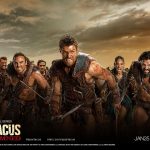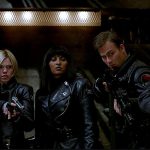“The Big Red One (1980)”
- movieslovers
- November 12, 2024

“The Big Red One” (1980) is a World War II war film directed by Samuel Fuller, who also co-wrote the screenplay. The film is a semi-autobiographical account of Fuller’s experiences as a soldier in the U.S. Army during the war. It focuses on the experiences of a squad in the 1st Infantry Division, famously known as The Big Red One, which served in key battles across Europe during the war. The film is known for its gritty portrayal of the horrors of war, the bond between soldiers, and the personal and emotional toll of combat.
Plot Summary
The story follows Sgt. Zachary (Lee Marvin), a hardened and cynical officer, who leads a group of soldiers through several major campaigns of World War II, including battles in North Africa, Sicily, Normandy, and Belgium. The squad includes young, inexperienced soldiers who gradually mature and adapt to the brutal realities of war.
The central narrative focuses on four main characters in the squad:
- Sgt. Zachary (Lee Marvin), the battle-hardened leader who struggles with his role as a leader while keeping his squad together in the face of insurmountable odds.
- The Private (Mark Hamill), a naive and young soldier who is thrust into the brutality of war, and whose character arc explores his growth and the toll combat takes on him.
- The Corporal (Robert Carradine), another member of the squad who has a sharp sense of humor and plays an essential part in maintaining morale.
- The Soldier (Bobby Di Cicco), who becomes close with the main characters and faces significant struggles as the war drags on.
The film explores the bond these men share as they face the overwhelming devastation of war, including moments of camaraderie, fear, and tragedy. As the story progresses, the squad experiences both the physical toll of war—losing comrades and fighting through unspeakable conditions—and the psychological scars left by constant exposure to violence and death.
The film is structured in a series of vignettes set against different theaters of the war, with the squad participating in major combat operations, such as the Battle of Normandy (D-Day) and the liberation of concentration camps, showcasing the brutality and futility of war. Despite the horrors, the film also focuses on the brotherhood that develops between the soldiers, their shared experiences, and the personal growth they undergo.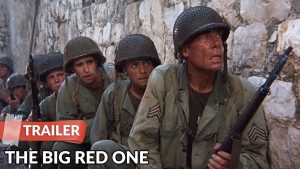
Key Themes
- The Horrors and Futility of War: One of the key themes of The Big Red One is the graphic portrayal of the brutal realities of war, especially for the common soldier. It doesn’t shy away from showing the harsh conditions, pointless violence, and loss of life that are part of war. The film emphasizes the seemingly endless cycle of violence and the emotional toll it takes on those involved.
- Brotherhood and Camaraderie: Despite the grim backdrop, the film highlights the deep bonds formed between soldiers in battle. The squad members come from different walks of life, but their shared experiences in combat create a sense of brotherhood that helps them survive. The film explores how men in combat often rely on one another for emotional support and survival.
- The Impact of War on Youth: The film also explores the impact of war on young soldiers, particularly through the character of the Private (played by Mark Hamill), who is thrust into the horrors of battle. His transformation from a naive young man to a more hardened individual reflects the brutalizing effects of combat on those who are forced to grow up too quickly.
- Leadership and Morality: Sgt. Zachary’s character embodies the complex and often morally ambiguous nature of leadership in war. While he is responsible for the lives of his men, he also struggles with the ethical dilemmas that come with commanding them in such a brutal environment. His character’s emotional burden and the difficulty of making decisions in life-or-death situations are central to the film’s exploration of war.
- Survival and Loss: The theme of survival in the face of overwhelming odds is central to the film. The soldiers are constantly confronted with death and loss, yet they persist, relying on each other and their own will to survive. The toll of these losses, both physical and psychological, forms a key emotional thread throughout the film.
Character Development and Performances
- Sgt. Zachary (Lee Marvin): Lee Marvin delivers a powerful performance as the grizzled, world-weary sergeant. He is a man who has seen it all and struggles with his role as a leader. Marvin brings depth to the character, capturing both the toughness and the internal conflict that comes with leading men into battle. His stoic demeanor hides a man haunted by the brutalities of war.
- The Private (Mark Hamill): Mark Hamill, known for his role as Luke Skywalker in Star Wars, portrays a young, idealistic soldier who is thrust into the horrors of war. His character’s transformation over the course of the film is heartbreaking and realistic. Hamill’s portrayal captures the emotional vulnerability and gradual hardening of a soldier who must come to terms with the violence and chaos around him.
- The Corporal (Robert Carradine): Robert Carradine brings a lighter, more humorous touch to the film with his portrayal of the Corporal. He balances the grim tone of the film with moments of levity, showing the emotional resilience of soldiers who use humor as a coping mechanism in the face of adversity.
- The Soldier (Bobby Di Cicco): Bobby Di Cicco’s character serves as another key figure in the squad, and his performance captures the camaraderie and emotional range that soldiers experience in the heat of battle. His interactions with other members of the squad add a sense of unity and brotherhood to the story.
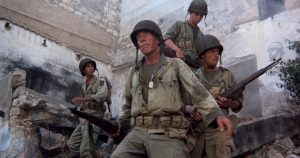
Cinematography and Direction
The cinematography of The Big Red One effectively captures the desolate and chaotic nature of war. The film uses sweeping shots of battlefields, close-ups of soldiers’ faces, and intense action sequences to create a visceral and immersive experience for the audience. The film’s gritty and realistic style is complemented by its use of practical effects, which emphasize the harshness and authenticity of the combat scenes.
Director Samuel Fuller, a former soldier himself, brings a sense of authenticity to the film, with a focus on realism and emotional truth. Fuller’s experience in the military gives the film an insider’s perspective on the life of a soldier, and he doesn’t shy away from portraying the emotional and physical toll that war takes on those who fight it.
Reception and Legacy
The Big Red One received mixed reviews upon release but has since gained recognition as a powerful, realistic portrayal of the horrors of war. While the film’s pacing and structure were sometimes criticized, its strong performances, especially from Lee Marvin and Mark Hamill, and its unflinching depiction of war have earned it a place as a significant entry in the war film genre.
The film has gained a cult following over the years for its honest portrayal of the emotional and physical scars of war. The Big Red One stands out for its emphasis on the psychological impact of combat, its character-driven narrative, and its exploration of the human cost of war.
Cast and Crew
- Director: Samuel Fuller
- Writers: Samuel Fuller (screenplay), based on his experiences as a soldier in World War II
- Cast:
- Lee Marvin as Sgt. Zachary
- Mark Hamill as The Private
- Robert Carradine as The Corporal
- Bobby Di Cicco as The Soldier
- Kiichi Nakai as Japanese Prisoner
- Geoffrey Lewis as Captain
- Vincent Gardenia as General
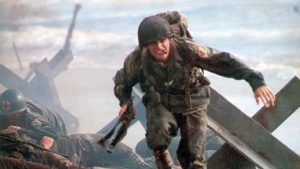
Fun Facts
- Samuel Fuller’s Real Experience: Director Samuel Fuller served as a soldier in the 1st Infantry Division, which is portrayed in the film. His experiences in World War II directly influenced the story and tone of The Big Red One.
- Mark Hamill’s Role: Mark Hamill, who would become famous for playing Luke Skywalker in Star Wars, was cast in a dramatic role in this film, showcasing his range as an actor.
Conclusion
The Big Red One (1980) is a poignant and unflinching portrayal of the brutal realities of war and the emotional toll it takes on soldiers. Directed by Samuel Fuller, the film captures the camaraderie, sacrifice, and trauma that soldiers experience in combat. With strong performances, particularly from Lee Marvin and Mark Hamill, and its gritty, realistic depiction of warfare, The Big Red One remains a powerful and memorable film in the war genre. It is a film that portrays the human cost of war, focusing on the emotional and psychological struggles of those who are forced to fight.







